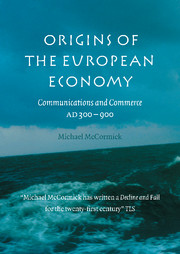Book contents
- Frontmatter
- Dedication
- Contents
- List of maps
- List of figures
- List of tables
- List of charts
- Preface
- List of abbreviations
- Commerce, communications, and the origins of the European economy
- PART I THE END OF THE WORLD
- PART II PEOPLE ON THE MOVE
- 5 A few western faces
- 6 Two hundred more western envoys and pilgrims: group portrait
- 7 Byzantine faces
- 8 Easterners heading west: group portrait
- 9 Traders, slaves, and exiles
- People on the move
- PART III THINGS THAT TRAVELED
- PART IV THE PATTERNS OF CHANGE
- PART V COMMERCE
- Appendices
- Bibliography
- Index
8 - Easterners heading west: group portrait
from PART II - PEOPLE ON THE MOVE
Published online by Cambridge University Press: 05 February 2015
- Frontmatter
- Dedication
- Contents
- List of maps
- List of figures
- List of tables
- List of charts
- Preface
- List of abbreviations
- Commerce, communications, and the origins of the European economy
- PART I THE END OF THE WORLD
- PART II PEOPLE ON THE MOVE
- 5 A few western faces
- 6 Two hundred more western envoys and pilgrims: group portrait
- 7 Byzantine faces
- 8 Easterners heading west: group portrait
- 9 Traders, slaves, and exiles
- People on the move
- PART III THINGS THAT TRAVELED
- PART IV THE PATTERNS OF CHANGE
- PART V COMMERCE
- Appendices
- Bibliography
- Index
Summary
The distinctive faces of the half dozen eastern travelers we have just met stand up well against the overall group of 340 “eastern” travelers. “Easterners” are slightly more numerous than the “westerners.” In their overwhelming majority, they were “Byzantine.” Most (at least 247: 73 percent) were Greeks by political allegiance; a much smaller number (34: 10 percent) were of Greek culture, although they resided in the Arab world. A handful (18: 5 percent) were Arabs, mostly attested in Latin or Greek sources; the others are of uncertain political and geographic background. The term “eastern” is no more than a convenient shorthand for this polyglot group, since it includes some Italo-Byzantines and a couple of Africans.
We have included primarily “easterners” who crossed borders. Generally speaking, internal patterns of movement between the capital and western provinces of the Byzantine empire have not been taken into exhaustive account. Once the broad patterns of long-distance movement across boundaries have been clearly established, others may wish to analyze their correlations with the internal communications which wove together the Byzantine provinces and capital and, indeed, with similar communications inside the Islamic world.
Byzantine Italy's shifting political geography complicates the issue. Places like Rome or Venice are obviously crucial to our theme in the ninth century, although they were still very much a part of the Byzantine empire at the outset of the eighth.
- Type
- Chapter
- Information
- Origins of the European EconomyCommunications and Commerce AD 300–900, pp. 211 - 236Publisher: Cambridge University PressPrint publication year: 2002



